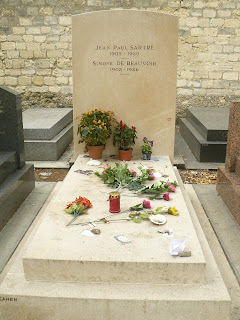Since last Wednesday’s sudden downpour, I had been nursing a slight cold and was coughing a bit. So before launching on our trip to the Arc d’Triomphe and Eiffel Tower west of the city, we went to look for a pharmacy in one of the streets on route.
It turned out to be quite a trip to the streets past the Palais Royal, formerly known as the Cardinal’s Palace because it was built by Cardinal Richelieu, appointed First Minister by Louis XIII, in the mid 1600s. On his deathbed, the Cardinal willed the estate to the King, thus the name Palais Royal. Only a fragment of the palace survives; now the Comedie Francaise and the Palais Royale Theatre form part of the complex. Moliere, acting there in one of his own plays, Le Malade Imaginaire (The Imaginary Invalid), collapsed on the stage in 1673, and died shortly thereafter.
On July 13, 1789, at now-gone Café Foy in the Palais Royal, Camille Desmoulins jumped up on a table and shouted for the mob to fight to the death, marking the start of the French Revolution.
As we exited the buildings now housing the Ministry of Culture and the State Council, we came across rows upon rows of stunted columns by artist Daniel Buren in the courtyard’s pavement. The columns stood like chess pieces waiting to be moved. We were moved by the artist’s sense of play.
Had we known earlier, we could have looked for the houses of famous people who once lived in the apartments in the area. Along rue Galerie de Beaujolais, on No. 9, facing rue Vivienne, was the home of the novelist Colette. On rue Monpentsier, southward, on No. 36, once lived the artist Jean Cocteau. But since looking for famous people’s homes was not on our agenda, we continued to walk the huge streets past the Opera House, on to Place Vendome (see two photos above), home of the Ritz, Chanel, banks and lux stores in a square dominated by the statue of Napoleon.
Champs-Elysées
To get to the Arc de Triomphe, we crossed the famed rue du Faubourg St-Honoré, home to the big designer houses, and on to the mass market and teen stores along the Right Bank on Champs-Elysées.
The Champs-Elysées was designed by Parisians to indulge in their favourite pastime: the promenade. Part of the walk, we found out, was through a chestnut-lined park, and the rest, along a commercial avenue filled with sidewalk cafes, sports and shoe stores, video and computer outlets, fashion boutiques, and fast-food joints.
Arc de Triomphe
By this time, our feet had swelled with our bunions’ constant pounding of the pavement. But the Arc de Triomphe beckoned just another three hundred metres away, so we persevered.
The Arc was worth the agony of our long walk. It stood like one of those ancient Roman arches about 163 feet high and 147 feet wide, the biggest triumphal arc in the world. It had been commissioned by Napoleon in 1806 to commemorate his victories. It’s now the site of the permanent tomb to France’s Unknown Soldier.
The Eiffel Tower
In 1889 when it was built, the Eiffel Tower, at 981 feet, was the tallest edifice in the world. Although other more modern and much taller towers had been built since then, the Eiffel Tower remains a sight to behold: an open framework construction weighing about 7,000 tons.
We stood underneath the tower and tried to count the two and half million rivets lining the rocket of steel lacework. We stopped counting at 2,010 rivets (in honour of the Year 2010), because by then we were out of breath and choking with awe.
The French know how to project their pride in their roots, heritage and accomplishments. No wonder Albertans claim to be in Canada’s province with the biggest: the world’s largest Ukrainian Easter egg near Vegreville, the world’s largest bee in Falher, the world’s biggest kielbasa sausage in Mundare and the largest softball in Chauvin, to name just a few.
Since we still had plenty of time in our hands, we took the Metro to Montparnasse to visit its famous cemetery. This is where the fun begins. Although the cemetery is replete with landmarks pinpointing the graves of the famous and the infamous, merely using the map won’t bring you nearer or closer to the grave of the famous person you’d be looking for.
The much-sought-after joint grave of Jean Paul Sartre and Simone de Beauvoir, French existentialist philosophers and writers, although marked on the map as located on the centre of the cemetery, wasn’t where it was supposed to be. Instead, the helpful woman custodian on the entrance at avenue Edgar Quinet guided us to the site which was left of the main entrance.
As he searched grave upon grave looking for the famous pair’s joint grave, Joe stumbled upon his favourite playwright Eugène Ionesco’s tomb.
Soon enough, we also found poet Charles Baudelaire’s tomb on right end side of the cemetery, with some freshly-lain flowers on its well-kept grave.
Standing before these famous people’s graves only brought a twinge of sadness to us; yes, the solitude and insignificance of human existence becomes all the more stark as we encounter death in its abject manifestation, among the tombs of the famous and the-not-so famous. In the end, death puts us on a levelling field, yet even in death, depending on our circumstance, we could be lying under a tomb of marble or hogging space in a common potters’ field.
Jean-Paul Sartre and Simone de Beauvoir at the Balzac Memorial in 1920s.
Source: Wikipedia
Source: Wikipedia




























No comments:
Post a Comment